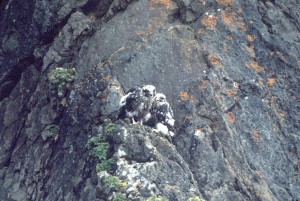According to a recent report from North Carolina Wildlife Resources Commission Mountain Wildlife Diversity Biologist, Chris Kelly, seven of 12 nesting pairs of peregrine falcons across the mountains of North Carolina successfully fledged chicks. Last year only three of 12 nesting pairs were successful.
NCWRC annually monitors 13 known peregrine territories and searches for falcons in other suitable habitat. This year, according to Kelly, 10 of the 13 known territories were occupied plus eyries were discovered at Pickens Nose, in Macon County and Victory Wall in Haywood County.
These two new nesting sites do have some peregrine history. Victory Wall, here in Haywood County, had nesting peregrines in the 1990s but the birds shifted to Devils Courthouse. Pickens Nose was a NCWRC hack site during the peregrine falcon reintroduction program.
Hacking is the process of taking chicks that were born in captivity to good nesting sites when they’re about a month old. They are kept in a protective enclosure and food is provided. There is minimal human interaction, so the chicks don’t imprint on people. When the chicks can fly, the enclosure is opened. Food is provided until the chicks begin to hunt for themselves.
One male, hacked at Pickens Nose nested successfully at Devils Courthouse a few years later. According to Kelly, peregrines were seen at Pickens Nose last year but nesting was not documented. This year two fledglings were documented.
Whiteside Mountain in Jackson County between Cashiers and Highlands is the most successful nesting site in the state. Forty-five chicks have fledged at Whiteside since 1984. Two fledglings were recorded this year. Last year was the first nesting failure at Whiteside in 11 years. There is no way to document, for certain, the cause of the failure but officials know that the closure was violated last year.
When falcons are known to be at a site, authorities close the area to rock climbing and other invasive activities for the duration of the nesting season. Peregrines are very sensitive to disturbance. Adults may leave the eyrie unattended if they are disturbed and frightened chicks have been known to tumble to their death.
Another long-time nesting site was also successful this year. A pair at Looking Glass in Transylvania County successfully fledged three chicks. Looking Glass was home, in 1957, to the last wild pair of peregrines before they disappeared from the state. Thirty-one chicks have fledged from Looking Glass since reintroduction began.
Second-year females were found at three sites this year – Big Lost Cove and Grandfather Mountain in Avery County and North Carolina Wall in Burke County. Nesting attempts at Big Lost Cove and North Carolina Wall were unsuccessful (not uncommon for sub-adult birds.) Kelly reported the results at Grandfather as “unknown.” She stated that a pair was observed at the “usual nest ledge” but it wasn’t clear if they nested. Grandfather boasts lots of remote rock faces that can make it hard for observers to locate birds. Nine documented chicks have fledged at Grandfather.
Grandfather also offered another surprise this year. The second-year female was banded but, according to Kelly, her state of origin could not be determined.
This year’s success is welcomed news. It’s heartening to see these kings and queens of the sky reclaiming their Carolina blue.

